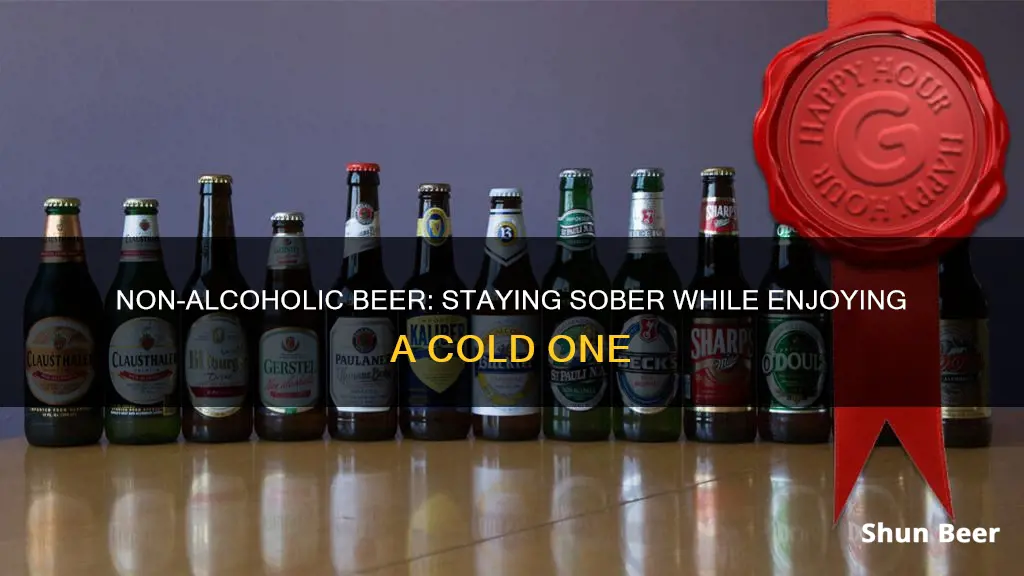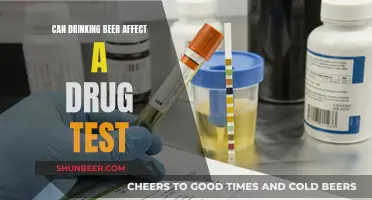
Sobriety is generally defined as abstaining from alcohol and drugs, and making conscious decisions to prioritise physical and mental well-being. However, the question of whether occasional drinking is compatible with a sober lifestyle is more complex. While some may argue that a single non-alcoholic beer is unlikely to trigger a relapse, others maintain that complete abstinence is the safest option for individuals in recovery. Ultimately, the answer depends on the individual's relationship with alcohol and their ability to control their consumption.
| Characteristics | Values |
|---|---|
| Alcohol Content | Non-alcoholic beer typically contains approximately one gram of alcohol. However, some may contain up to 0.5% alcohol by volume (ABV). |
| Risk of Relapse | Non-alcoholic beer may trigger cravings and increase the risk of relapse for people with alcohol use disorder. |
| Pregnancy Risk | Non-alcoholic beers may contain unsafe amounts of alcohol for pregnant individuals. |
| Social Benefits | Non-alcoholic beer can help individuals in recovery navigate social situations where alcohol is present, providing a sense of normalcy and inclusivity. |
| Individual Factors | The decision to consume non-alcoholic beer during recovery depends on individual circumstances, such as personal triggers and emotional associations. |
What You'll Learn

NA beer may still contain alcohol
Non-alcoholic beer (NA beer) is often marketed as a safe alternative to alcoholic beer, and it can be a good option for those looking to reduce their alcohol consumption. However, it's important to note that NA beer may still contain small amounts of alcohol.
In the United States, a beer can be labelled as "non-alcoholic" if it has no more than 0.5% ABV (alcohol by volume). This means that while NA beers have a lower ABV percentage than regular beers, they still contain trace amounts of alcohol. The amount of alcohol in these beverages can vary, so it's crucial to read the labels carefully before consuming them.
Some NA beers are labelled as "alcohol-free," which means they are required by the U.S. Food and Drug Administration (FDA) to contain 0.0% ABV. However, research suggests that many non-alcoholic beers contain higher levels of alcohol than indicated on their labels. An older study found that 29% of no- or low-alcohol beers tested had higher alcohol levels than stated, with six out of the zero-alcohol samples containing more than one percent alcohol.
The presence of alcohol in NA beers may pose risks for certain individuals, such as those with a history of alcohol use problems or those who are pregnant or trying to become pregnant. Additionally, the smell of NA beer, which is very similar to regular beer, may serve as a relapse trigger for people recovering from alcohol use disorder.
It's important to note that the effects of NA beer can vary from person to person. While it may not lead to intoxication or drunkenness, some individuals may still feel slightly different after consuming it, especially on an empty stomach. Overall, while NA beer can be a helpful alternative for those looking to reduce their alcohol intake, it's essential to be aware of its potential risks and make an informed decision based on individual needs and preferences.
Puppies and Beer: A Dangerous Mix?
You may want to see also

NA beer may trigger cravings for alcohol
Non-alcoholic (NA) beer contains little to no alcohol, typically less than 0.5% alcohol by volume. While NA beer can be a viable option for those who want to avoid the effects of alcohol, it may not be the best choice for those maintaining sobriety or recovering from alcohol use disorder (AUD).
Drinking NA beer may trigger cravings for alcohol, especially in individuals with AUD or a history of alcohol addiction. Cravings can be intense and are often driven by triggers, which can be internal or external. Internal triggers include thoughts, emotions, or physical sensations, such as a headache or nervousness, that prompt the urge to drink. External triggers refer to environmental cues associated with alcohol, such as places, times, people, or situations where one typically drinks.
For individuals in recovery, encountering these triggers can lead to intense cravings and increase the risk of relapse. Even the taste and smell of NA beer, which closely resembles regular beer, can evoke powerful memories and emotions associated with alcohol use, triggering cravings. The act of drinking NA beer, which mimics the behavioural routine of drinking alcohol, can also reinforce the desire to consume alcohol.
Additionally, NA beer may not be completely alcohol-free, and even trace amounts of alcohol can be problematic for individuals in recovery. It is important to note that the effectiveness of NA beer in triggering cravings can vary from person to person, and some individuals may find that NA beer does not trigger any cravings at all.
If you are concerned about triggering cravings or maintaining sobriety, it is advisable to avoid NA beer and seek alternative beverage options. It is crucial to prioritize your well-being and make choices that support your recovery journey.
Expired Ginger Beer: Is It Safe to Drink?
You may want to see also

NA beer may be beneficial for social situations
NA beer, or non-alcoholic beer, is often designed to taste and look like traditional beer but contains very little to no alcohol. This makes it a viable alternative for those who want to enjoy the taste and social experience of drinking beer without the intoxicating effects of alcohol.
NA beer can be particularly beneficial for individuals in recovery from alcohol addiction or those who choose not to consume alcohol for health, religious, or personal reasons. It allows them to participate in social gatherings where alcohol is present without feeling left out or pressured to consume alcoholic beverages. NA beer provides a sense of normalcy and inclusivity, enabling people to enjoy the taste and experience of beer while maintaining their commitment to sobriety.
For example, an individual in recovery shared their experience of using NA beer to navigate social situations: "I've been sober for 30+ years and drink a lot of non-alcoholic beers. [They] minimize any cravings". Another person in recovery expressed that NA beer helps them "feel included during social occasions without putting [their] sobriety at risk".
However, it is important to note that NA beer may still contain trace amounts of alcohol, and the smell and taste can trigger cravings or emotional associations for individuals with a history of alcohol addiction. Thus, it is crucial for those in recovery to assess their own triggers and consult with healthcare professionals or support groups to determine if NA beer is a suitable choice for their journey.
Beer's Impact: How It Affects Your Body and Health
You may want to see also

NA beer may be a tool for harm reduction
NA beer, or non-alcoholic beer, is a beverage that contains little to no alcohol. While NA beer may not get you drunk, it can still be considered a tool for harm reduction in certain contexts.
Harm reduction strategies are practical approaches aimed at reducing the negative consequences of high-risk behaviours such as substance use. Instead of demanding complete abstinence, harm reduction is a non-judgmental approach that supports individuals in making positive changes in their drinking habits. This can involve safer drinking, reduced drinking, or quitting alcohol altogether.
NA beer can be a valuable tool for individuals looking to cut back on their alcohol consumption or maintain their sobriety. For those who are unable or unwilling to abstain completely, NA beer provides an alternative that mimics the sensory experience of drinking alcohol without the same level of risk. This can be especially helpful for individuals in recovery from alcohol use disorder who wish to avoid the social scrutiny and isolation that can come with abstinence.
Additionally, NA beer can help individuals who are trying to reduce their alcohol intake by providing a lower-risk option. By choosing NA beer, individuals can still participate in social rituals and connections associated with drinking without compromising their recovery. It offers a way to address the underlying issues of addiction while maintaining a sense of normalcy and connection to others.
However, it is important to note that NA beer may not be suitable for everyone. Some individuals in recovery may view NA beer as a trigger or a "tease" that could lead to unwanted drinking behaviour. It is crucial to respect individual differences and tailor harm reduction strategies accordingly.
Overall, NA beer can be a valuable tool for harm reduction by providing a safer alternative to alcoholic beverages. It allows individuals to make positive changes in their drinking habits while maintaining their sense of connection to social rituals and traditions associated with alcohol consumption.
Enjoying Beer While Watching Champions League Games
You may want to see also

NA beer may blur the lines of sobriety
For individuals in recovery from alcohol use disorder, maintaining sobriety is a critical aspect of their journey. Consuming NA beer may trigger cravings or create an overwhelming obsession to drink more, which could lead to a relapse. It is important for those in recovery to carefully assess their relationship with alcohol and make informed decisions about their consumption, including NA beer. Seeking guidance from medical professionals or support groups can be beneficial in navigating this complex issue.
The definition of sobriety may vary for different individuals. For some, sobriety may mean complete abstinence from alcohol, while others may interpret it as moderate or controlled drinking. NA beer may challenge this definition, as it blurs the line between non-alcoholic and alcoholic beverages. Individuals who choose to consume NA beer should be mindful of their consumption patterns and be cautious not to slip into unhealthy habits.
Additionally, NA beer can impact the social aspect of drinking. Social gatherings often involve alcoholic beverages, and the presence of NA beer may create a sense of inclusion for those who do not consume alcohol. However, it is important to recognize that NA beer is not a direct substitute for alcoholic beverages and that the experience of drinking it may differ from that of regular beer.
In conclusion, NA beer may blur the lines of sobriety by creating a grey area in the drinking landscape. It is important for individuals to make conscious and informed choices about their consumption, considering their personal history, relationships with alcohol, and overall well-being. While NA beer may be a viable option for some, it is crucial to prioritize physical and mental health and seek professional guidance if needed.
Beer and Diabetes: What Diabetics Need to Know
You may want to see also
Frequently asked questions
It depends on your definition of sobriety and your relationship with alcohol. If you are a recovering alcoholic, it is recommended that you completely abstain from drinking alcohol to avoid the risk of relapse. However, if you are living a sober life by choice and not due to addiction, the occasional drink may not be considered a relapse. Ultimately, it is up to the individual to define their relationship with alcohol and set their boundaries.
On average, it takes about two hours for the body to metabolize one standard drink. However, this can vary depending on factors such as the amount of alcohol consumed, the speed of drinking, whether the alcohol was consumed on a full or empty stomach, and individual factors such as body weight, liver function, and sex.
No, there is no way to speed up the elimination of alcohol from the body. While coffee, cold showers, or exercise may make you feel more alert, they do not impact your blood alcohol concentration (BAC) level. Eating food before drinking can slow down the absorption of alcohol and give your body extra time to process it, but eating after drinking will not speed up its elimination.
As your BAC rises, you may experience a range of effects, including relaxation, euphoria, impaired judgment, loss of inhibition, impaired motor coordination, slurred speech, poor coordination, slowed thinking, vomiting, confusion, loss of muscle control and balance, and blackouts. At very high BAC levels, respiratory failure and death can occur.







